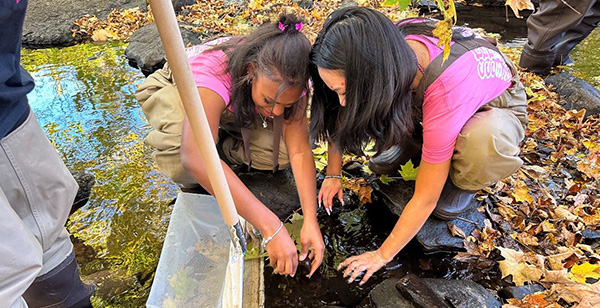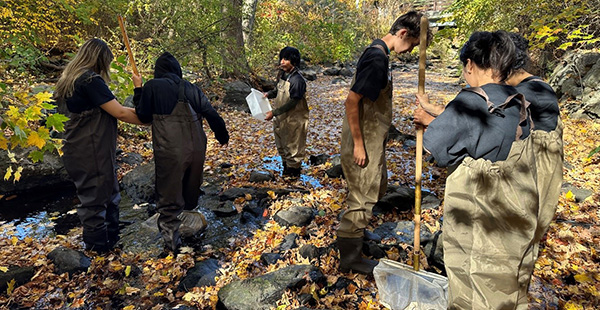
The section of the Byram River where the students stood was only shin deep. Still, David Abreu could tell they were fully immersed in their work.
“I was watching them picking up rocks, using the kick nets, grabbing all the bugs from the nets. You could see their faces brighten up when they realized, ‘Oh my gosh, I’m actually out here in the river,’” said David, Save the Sound’s clean water advocacy specialist. “It’s different than being in a classroom setting. They might pick up on the material in a classroom, but it’s not the same as when you’re out there physically doing it.”
David held two classroom sessions in early October, teaching 10 students from the Port Chester Youth Bureau about water quality and river ecology as part of our Green and Blue Learning Lab, a project funded by the Environmental Protection Agency through Restore America’s Estuaries. He was preparing them for performing research tasks later that month— a macroinvertebrate field survey in the Byram River, which connects New York and Connecticut. They planned to collect samples of “river bugs,” as described by Connecticut Department of Energy and Environmental Protection in its Stream Riffle Bioassessment by Volunteers program overview. Identifying and documenting the presence of certain species of macroinvertebrates can help evaluate the health of a waterbody.
“They’re looking for biological indicators of water quality,” said Peter Linderoth, director of science and watersheds for Save the Sound’s Healthy Waters Institute. “Different animals handle water quality in different ways. Some thrive in a clean environment, others can exist in poor water quality situations. An abundance and mix of certain types demonstrates good water quality, while an abundant presence of other types indicates poor water quality.”
What David couldn’t fully prepare the students for, however, was how much being in the water would change their relationship to it. It was a lesson he hadn’t himself learned until a just few years ago.
David grew up in the Soundview section of the Bronx, but like so many kids—whether in the city or suburbs—never gave much thought to the water quality of the rivers running through his community. When he joined the Bronx River Alliance on a paddle tour for community members in 2021, his perspective changed forever.
“We launched out of Concrete Plant Park for an estuary paddle out to the mouth where the Bronx River meets the Upper East River,” he said. “We saw great egrets, blue herons, all these birds I never expected to see. We passed by all the native plants and trees you don’t even realize are there. You’re taken out of the city and put out into the native ecology of the Bronx. I wish I’d done more of that as a kid, and that’s why it’s so important to introduce the students to the nature that’s right there for them in Port Chester.”

The macroinvertebrate sampling was just the first hands-on experience for the students of the Green and Blue Learning Lab. In the coming weeks, they are planning a field trip to get up close with more aquatic animals who call Long Island Sound home.
Then, in the spring, the students will install a rain garden at William James Memorial Gateway Park, a pump station on Route 1; the building is in Port Chester, NY, but the Byram River behind it is in Greenwich, CT. David is working with the Department of Public Works to install gutters that would flow directly into the rain garden, to be dug and planted by the students.
“We had a classroom component talking about the benefits of rain gardens in general, how they help filter stormwater and protect water quality,” said David. “We’ll have another prep session before then to talk about the tools we’ll be using and what they can expect to do that day.”
It’s another opportunity for the students to learn about the impact they have on water quality, and the lasting impact being connected to the water can have on them.
